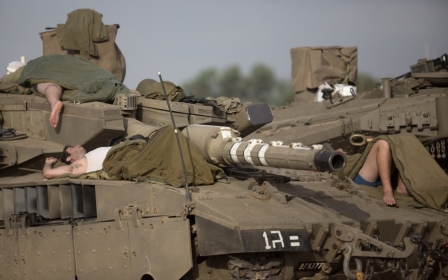No exit from Gaza: A new war crime?
Published date: 12 February 2015 17:00 GMT
|
Last update: 9 years 2 months ago
The civilian population of Gaza are trapped in an overcrowded war zone with no form of exit. This situation reveals a serious gap in international humanitarian law

As the hideous Israeli assault on Gaza, named Operation Protective Edge, by the IDF enters its second week, overdue international appeals for a ceasefire fall on deaf ears. Bibi Netanyahu tells the world that no outside pressure will alter Israel’s resolve to reach its military and political goals to disable Hamas for the indefinite future. The purported justification for such aggression is to make sure this time that Israelis will never again have to seek shelter from Hamas rockets, which could require a prolonged military campaign combining ground forces with a continuing air and naval assault.
Leaving aside the debate on causes and justifications, the civilian population of Gaza, estimated to be about 1.7 million with women and children comprising 75% of the total, are trapped in an overcrowded war zone with no apparent exit from terrifying danger. Even if families are lucky enough to avoid direct physical injury, the experience of screaming jet fighters attacking through the night, targeting and surveillance drones overhead day and night, sustained naval artillery barrages, not to mention the threatened ground invasion combine to create a continuous horror show. It has been repeatedly confirmed by mental health specialists that these realities act as a trauma inducing phenomenon on a massive scale with prospects of lasting psychological damage, especially to children.
With these elements in mind, the idea of fulfilling the basic objective of international humanitarian law to protect civilians caught in a war zone is being violated by Israel, although not altogether. Israeli officials claim that leaflets dropped on some intended targets are giving residents a few minutes to vacate their homes before they are reduced to rubble, although this is hardly enough to satisfy the obligations of an Occupying Power under international humanitarian law. In a further escalation of the attacks, perhaps the prelude to a ground invasion, residents of northern Gaza are being told to flee the area, and tens of thousands have apparently done so.
Hamas is said to be urging these same people not to leave their homes, dismissing Israeli threats as intimidating propaganda. Cynically interpreted, Hamas appears to be informing Israel that if they go ahead and invade, there will be many Palestinian civilian casualties, and the shock of such carnage will help eventually swing the international balance of opinion strongly in their favor.
The entrapment of the Gazan population within closed borders is part of a deliberate Israeli pattern of prolonged collective punishment that has for the past several years been imposed on Gaza. This amounts to a grave breach of Article 33 of the Fourth Geneva Convention, which qualifies as a potential Crime Against Humanity. The clarity of criminal intent is further disclosed by Israel’s willingness to allow 800 or so Gazans who have dual citizenship and hold a foreign passport to leave Gaza by entering Israel at the Erez Crossing, including 150 holding American passports.
No other residents of Gaza have the option of leaving, whether disabled, sick, elderly, or young. The civilian population of Gaza is denied the possibility of seeking refugee status by fleeing Gaza during this time of intense warfare, and there is no space available that might allow Palestinian civilians to become internally displaced within Gaza until Protective Edge ends.
In countries such as Iraq and Syria we grieve appropriately for the millions becoming refugees or ‘internally displaced,’ compelled by the dangers of the raging conflict to seek refuge somewhere in the country that is removed from the war zone. We can sense the extremity of the humanitarian tragedy in Gaza by realizing that these people whose lives despite being acutely jeopardized, have no place to hide from the brutalities of war. The whole of the Gaza Strip is a war zone. Gazans who have endured many mortal threats and a siege that has lasted many years, are currently at a moment of extreme hazard, and yet have no possibility of seeking temporary safety as refugees by crossing an international border.
The idea of internal refuge is almost inapplicable given the ferocious nature of Protective Edge that has spared not one corner of the tiny and overcrowded Gaza Strip. To be sure, in response to Israeli warning to leave tens of thousands of Palestinians are fleeing south from north Gaza. At present writing , an estimated 17,000 Palestinians have obtained refuge in the 20 UN-run schools situated throughout Gaza. UNRWA is doing its heroic best to handle these desperate people but its buildings have limited space and lack the facilities to handle properly this kind humanitarian emergency--insufficient bathrooms, no beds, and not enough space to meet the demands.
This is not the first time that this exit challenge has been posed in Gaza. Back in 2008-09 and 2012, Israeli launched major military operations in Gaza, and the issue of the entrapped civilian population was brought to the attention of the UN and the international community, a challenge met with silent irresponsibility. The encirclement of Gaza by Israeli controlled crossings and fences, even aggravated as compared to the past by an Egyptian political leadership that makes no secret of its hostility to Hamas, is catastrophic in the risk it poses to the totally vulnerable Gazan social reality.
For some perspective, it is useful to recall that just prior to the Kosovo War in 1999, up to a million Kosovars crossed into Macedonia to escape anticipated NATO air strikes and because of a credible fear of an imminent ethnic cleansing campaign carried out by Serbian forces then controlling the country. As soon as the war was over and Serbia abandoned Kosovo, these refugees returned, having safely navigated the dangers of the war. In Libya, too, the international community meaningfully responded in 2011 to the urgent crisis of an entrapped civilian population. In the Libyan crisis Security Council members talked piously about relying on the emergent norm of international law known as the Responsibility to Protect, or R2P, that validated intrusion on Libyan sovereignty by way of a No Fly Zone that was established to protect the civilian population of Benghazi facing the vengeance of Gaddafi’s forces.
This 2011 intervention has been much criticized because the humanitarian justification was converted into a regime-changing intervention that raised many objections, but what is relevant here is that the UN and the member governments of the Security Council acknowledged their responsibility to do something to protect a civilian population unable to remove itself from a combat zone. It should not be forgotten that humanitarian appeals seem much more effective when the country in question is perceived to have strategic value, especially large oil deposits.
This makes the UN and international failure to act unforgiveable with respect to the people of Gaza, so often severely threatened with dangers that approach genocidal thresholds. Even so the UN and its leading member governments turn their heads and look away. This exhibits either a sense of helplessness in the face of Israel’s military juggernaut or even more disturbingly, a silence that can be construed as tacitly blessing this infernal entrapment of innocent and long suffering people.
International law has little to say. International refugee law avoids issues associated with any right to escape from a war zone or duty of the belligerent parties to provide civilians with an exit and/or a temporary place of sanctuary. International humanitarian law offers little more by way of protection to an entrapped people, despite the seeming relevance of the Fourth Geneva Convention devoted to the Protection of Civilians in Time of War.
There is accorded to foreign nationals a right of departure with the onset of war, including even repatriation to an enemy country, but no right of nationals to leave their own country. And the generalized obligation of an Occupying Power to protect the civilian population is legally subordinated to its security needs, including military necessity, and so is generally of little practical use.
What is evident in relation to the entrapped civilian population of Gaza is that no legal obligation exists to provide for safe havens either within the country experiencing the warfare or beyond its borders. At minimum, this horrible cauldron of violence and vulnerability reveals serious gaps in international humanitarian law, as well as the collapse of moral constraints on belligerent violence. Such a situation urgently calls for a supplemental international agreement in the form of a treaty protocol to the Geneva Convention conferring a right of exit to civilians entrapped in a war zone. There is also a need to make the denial of the right of exit a species of war crime within the purview of the International Criminal Court.
It should also be considered whether there should be conferred a right of internal displacement, imposing an obligation of the territorial government or insurgent actor both to respect enclaves set aside for displaced persons and to allow departure from war zones so as to take advantage of internal displacement. There are complications that need to be addressed including whether the territorial government or occupying power can invoke security considerations to deny exit and displacement rights to those about whom there are suspicions.
For the present it is enough to observe that the civilian population of Gaza finds itself totally entrapped in a terrifying war zone, and that the UN and neighboring governments have refused to accept responsibility to offer some form of humane protection. It is one aspect of the dual unacceptability of the Israeli military operation from a moral perspective and of the failure of international humanitarian law to lay down suitable rules and procedures that respect the human dignity of civilian innocence so entrapped.
- Richard Falk is an international law and international relations scholar who taught at Princeton University for forty years. In 2008 he was also appointed by the UN to serve a six-year term as the Special Rapporteur on Palestinian human rights
The views expressed in this article belong to the author and do not necessarily reflect the editorial policy of Middle East Eye.
Photo: Palestinians inspect destroyed buildings after Israeli airstrikes staged within the 'Operation Protective Edge' in Gaza City, Gaza on July 15, 2014 (AA)
Stay informed with MEE's newsletters
Sign up to get the latest alerts, insights and analysis, starting with Turkey Unpacked
Middle East Eye delivers independent and unrivalled coverage and analysis of the Middle East, North Africa and beyond. To learn more about republishing this content and the associated fees, please fill out this form. More about MEE can be found here.





